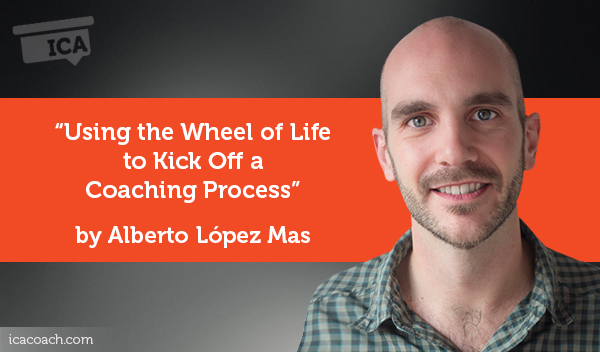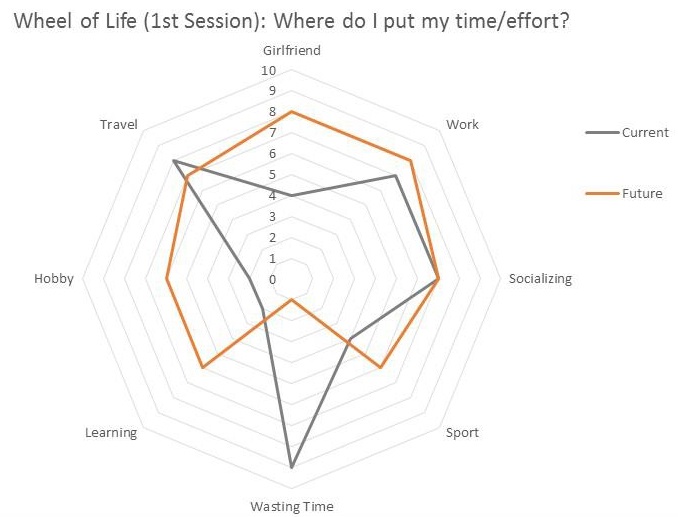
Research Paper By Alberto López Mas
(Life Coach, VIETNAM)
Introduction
This document showcases the use of the Wheel of Life as a lever to unblock the client’s situation, and launch and give structure to a whole coaching process.
In its original form, this tool is formed by a circle divided in eight sections like the spokes of a wheel. These sections represent the client’s key life areas and he/she rates both the current and ideal level of satisfaction in each of them. Then, it is then easy to find the gaps and areas to focus the attention on.
The main advantages of this tool are its readiness, ease of use and customization, because each client defines his/her main life areas.
However, during this case study the Wheel of Life is not used to assess the client’s satisfaction on his/her life. Rather, I use it as a general framework to analyze the situation at hand and define objectives.
Client and Coaching Case
K. is a young lawyer in his mid-twenties. He lives with his girlfriend, P., who is launching her own online business. K. is happy with his job and usually has an active social life on weekends, engaging with friends and making plans. He initially described his life as “normal, without any big drama”.
However, in the last months K. is feeling unmotivated and lacking energy. For him, using his time “correctly” is very important, but he stays more at home, just watching TV or “wasting his time” (sic). He feels also less sociable, going out less and not proposing new plans with his friends, something that he used to do. K. thinks that this situation is a product of a “gradual sip into bad habits”: not setting targets, not organizing his time and falling into laziness.
K.’s objectives for the coaching process are: organizing better his time (in order to feel that he is using well), and setting up clear short-term goals to regain his motivation. For him, feeling that he has spent his time effectively is very important. When considering what is preventing him to achieve these goals, he concludes that there is not a single main reason; it has been something progressive in the last months or year.
K. considers that his biggest strengths are that he is “logical”, “independent thinker” and “very good at analyzing situations”.
Coaching Process
At the beginning of the first session the client had problems trying to define the goal and even where to start the whole process. He felt he was not organizing his time well, but could not see what area of his tasks to focus on. This was even more frustrating for him, as he considered himself very analytical. It was obvious that he had spent time going around the problem, but could not grasp it. He felt blocked by his own inertia, and could not find a way to put himself in motion.
This was reflected on his own language: “wasting time”, “bad habits that have crept into my life”, “gradual slip [into these bad habits]”, “my own laziness, grumpiness, lack of motivation which has grown into a confidence dip and created a vicious circle”, “I need to shake up my life”. There was a sense of imprecision and lack of clarity, of a steady process rather than a sudden problem.
On the other hand, he had a clear sense of what he wanted to achieve and how he expected to feel as a result, and that could be a powerful starter.
I explained him about the Wheel of Life tool and he agreed to use it. The reasons to propose this tool were that:
Instead of the original formulation of the Wheel of Life (as explained previously), I focused it on the problem as expressed by K.:
- I asked him to list the eight areas where he spends most of his time.
- For each of them, he had to answer the questions “How much time/effort do I spend here?” and “How much time/effort do I want to spend?”
- He drew the results in a web diagram.
 After he finished, I asked him to explain his categorization and rating so as to help him:
After he finished, I asked him to explain his categorization and rating so as to help him:
This exercise led K. to some important conclusions:
This material gave a new sense of direction to K. He now had clear areas of action and ideas on what he really wanted to achieve, so we planned the rest of the process accordingly. He decided to use the following sessions to these areas, initially one session for each, but adjusting based on how he advanced.
For the first time in months, K. had a road map to overcome his situation. This didn’t relieve him completely, though, because he felt he had many tasks ahead. Again, he was afraid that his “inertia” would bring him down. In order to start moving and gain traction, we worked on some quick wins: easy steps he could take before the next session. He chose to focus on the “Hobby” and “Learning” areas by finding and contacting a teacher to start playing an instrument. This was a great move on his side: he was not committing to study piano five years, only to take a simple first step and check if he liked it, and it increased his motivation.
Learning Points
This was an interesting way to kick off a coaching process, and I think that K. did a great job. My key learning points are the following:
- Using tools that rely on the client’s strengths and adapt them to the situation maximize the outcomes.
- Devoting as much time as needed to clarify the goals for the session and the whole process may seem cumbersome, but actually saves time and energy, and produces better results.
- Trying to create with the client a plan for the coaching process as a whole. In this case, K. was feeling stuck, and having a road map that he could tailor depending on the circumstances gave him greater confidence in himself and in the process.
- Getting some quick wins from the beginning increases motivation and helps to put the process in motion.